Step Into Reno’s Past
Summer 2022
Take this guided stroll of the town’s cultural center.
BY CORY MUNSON

So you’re in Reno and want to get acquainted with the city: where should you start? Consider this walking tour a primer for exploring the city. Beginning next to the neon and nightlife of downtown, you’ll end your walk on a bohemian street where locals shop and dine. Along the way, discover a post office-turned-indie mall, a riverside restaurant on Reno’s most historic site, and one of the town’s earliest buildings. We begin just south of the Truckee River right after crossing the bridge on Virginia Street.
DOWNTOWN POST OFFICE (1933)
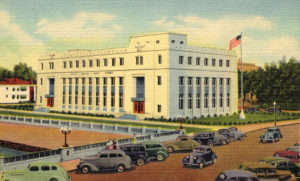
In 1931, Nevada passed two laws that were found nowhere else in the country: legalized gambling and speedy divorces. As the largest town in the state, Reno quickly became America’s hottest tourist destination.
To support the flood of mail that followed visitors, a new post office was needed. Officials chose a site that was then home to the Carnegie Free Library, built in 1904 after Andrew Carnegie donated today’s equivalent of $1.5 billion to construct libraries across the nation. The small library had been vacant for years, so it was demolished to make room.
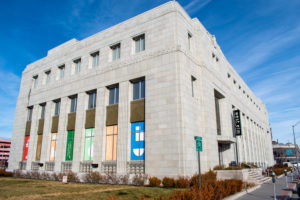 The new post office was designed by Reno-native Frederic DeLongchamps, a prolific architect whose work is found throughout northwestern Nevada, including the two buildings across the street: the Riverside Hotel and the Washoe County Courthouse.
The new post office was designed by Reno-native Frederic DeLongchamps, a prolific architect whose work is found throughout northwestern Nevada, including the two buildings across the street: the Riverside Hotel and the Washoe County Courthouse.
The post office was designed in the Art Deco style, a departure from the columns and vaulted ceilings found in many government buildings of the time. The exterior—terracotta made to look like chiseled granite—is decorated with fanlike aluminum grills and bands of geometric designs. Above the entrance, you’ll find massive eagles whose heads alone weigh 200 pounds apiece.
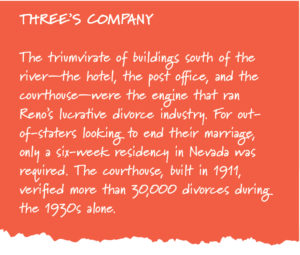 The inside is adorned with black marble, aluminum, a central skylight, and maple flooring. Keep an eye out for the intricate geometric designs that cover the interior, including an airplane and winged Mercury—symbols of progress—above the doors.
The inside is adorned with black marble, aluminum, a central skylight, and maple flooring. Keep an eye out for the intricate geometric designs that cover the interior, including an airplane and winged Mercury—symbols of progress—above the doors.
In 1975, a new main post office was built, and the downtown building continued as a branch until it was closed in 2012. The building was reopened in 2015 as a commercial space. On the main floor you’ll find well-preserved remnants of the old post office and a department store. Head downstairs and spend time wandering The Basement. This quirky marketspace is filled with tiny, independently owned stores and restaurants.
RIVERSIDE HOTEL (1927)
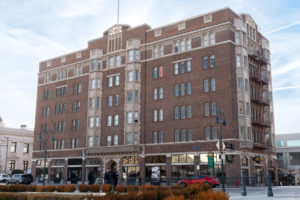
Across the street from the post office is a grand brick building that marks the site where Reno began. In 1859, Charles Fuller built the valley’s first permanent structures: a ramshackle inn and a wooden bridge. The station—called Fuller’s Crossing—was used by miners to cross the Truckee River on their way to the rich mines of Virginia City.
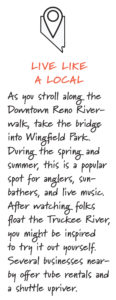 Two years later, a farmer named Myron Lake traded his California ranch for Fuller’s Crossing and replaced the old inn with a comfortable lodging called the Lake House.
Two years later, a farmer named Myron Lake traded his California ranch for Fuller’s Crossing and replaced the old inn with a comfortable lodging called the Lake House.
By 1907, Reno was an up-and-coming railroad town. The Lake House, now under new ownership, was demolished to make room for a monumental 110-room, castle-like brick building called the Riverside Hotel that was, unfortunately, destroyed by fire in 1922. The site was then purchased by George Wingfield—one of the richest men in the state—who hired DeLongchamps to design the fourth and final building to occupy the site.
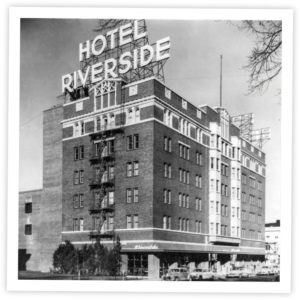
Wingfield’s six-story Riverside Hotel opened as the center of Reno’s social scene. After the end of Prohibition in 1933, this is where high society enjoyed drinking and gambling, and soon-to-be divorcées rented luxurious rooms.
By the 1960s, however, the Riverside Hotel’s fortunes began to fade, and apart from a brief revival in the 1970s, the building spent decades mired in bankruptcy and mismanagement. In the late 1990s, the Riverside was scheduled to be demolished—only to be saved in a last-minute local campaign led by the Sierra Arts Foundation.
Today, the building’s upper levels have been converted to artist lofts. Its west side was demolished, and a stroll over there will reveal The Eddy: an artsy container park offering food and drink (see page 110). On the bottom floor is the Wild River Grille—an excellent eatery where outdoor seating allows for the perfect view of the Truckee River.
LAKE MANSION (1877)
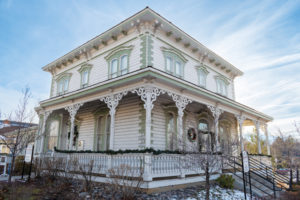
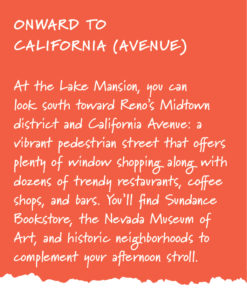 At this point, you might be wondering where you can find a building that is really old. From the Riverside, walk west—toward the Sierra Nevada Mountains—along the charming Riverwalk, then turn south at Arlington Street and walk a block up the hill. You’ll find the beautiful white manor that once belonged to Myron Lake.
At this point, you might be wondering where you can find a building that is really old. From the Riverside, walk west—toward the Sierra Nevada Mountains—along the charming Riverwalk, then turn south at Arlington Street and walk a block up the hill. You’ll find the beautiful white manor that once belonged to Myron Lake.
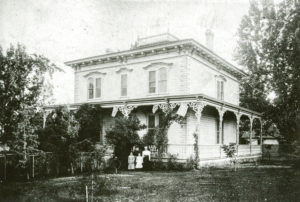
After purchasing Fuller’s Crossing, Lake made a fortune granting land rights to the railroad—a decision that literally put Reno on the map. Lake died a few years after purchasing the home, which then passed to his ex-wife and son.
Originally built on the corner of California and Virginia Street, the house was relocated to its present location in 2004. Today, the building is an art teaching and cultural center operated by Arts for All Nevada. Contact the organization to schedule a tour of the mansion.

